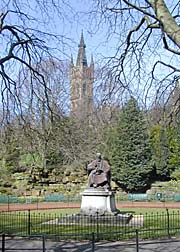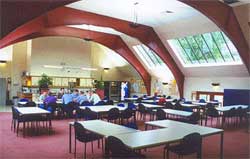About the School of Physics and Astronomy
The School of Physics and Astronomy is located in the Kelvin Building which is named after our famous nineteenth century Professor of Natural Philosophy. The members of staff in the school are not only teachers of Physics and Astronomy, but are also practising physicists and astronomers, actively pursuing many aspects of research.
History
There has been a chair of natural philosophy at the University since 1727 although the subject would have been taught in some form even before this. The most famous incumbent of this position was William Thompson, later knighted Baron Kelvin of Largs. He had a huge influence in many fields including in experimental physics research (the unit of absolute temperature is named Kelvin after him), in technology including intercontinental communication aiding the laying of the first telegraph cables between Britain and the USA, and in various areas related to shipping navigation. He also made vital steps forward in physics education and introduced practical laboratory based teaching at Glasgow.
Since his time, the school has grown massively and is now one of the leading Physics and Astronomy schools in the UK, both for undergraduate teaching, and for cutting edge research in a wider variety of fields.
Student Societies
The school has two active societies - PhySoc and AstroSoc - run by students for students. Apart from talks of general interest, the student societies organise a number of social events. The highlight of the year is usually the Christmas party.
Public Understanding of Science
The public promotion of science is an activity which both the staff and students of the school take very seriously. Many students (who are often much better than the staff) take part in these events, which are aimed at the general public and school students in particular.
Lectures, seminars and laboratories
The majority of our undergraduate lectures are hosted within the school in one of the many hi-tech lecture theatres. In addition to lectures, students receive support in smaller group tutorials and seminars. In all years of the degrees, the theoretical work taught in lectures and seminars is supplemented with more practical laboratory based learning in our recently refurbished teaching laboratories. In the case of students opting for the theoretical physics degree, the honours laboratories will take the form of more theoretical and computational assignments. For students taking astronomy, we have observatory and teaching facilities on the Garscube campus.
Computing Laboratory
Computers and the skills required to use them form an important part of our degree structure. With over 120 of the latest PCs dedicated for use of undergraduates, the school boasts one of the best facilities in the country.
Common Room
The heart of our School is the common room, an attic conversion from part of Kelvin's original lecture theatre. Spacious, bright, and fully equipped with refreshment vending machines, it is often used for private study in a relaxed atmosphere.
More Information
The student handbook contains detailed information on these and other relevant topics.

